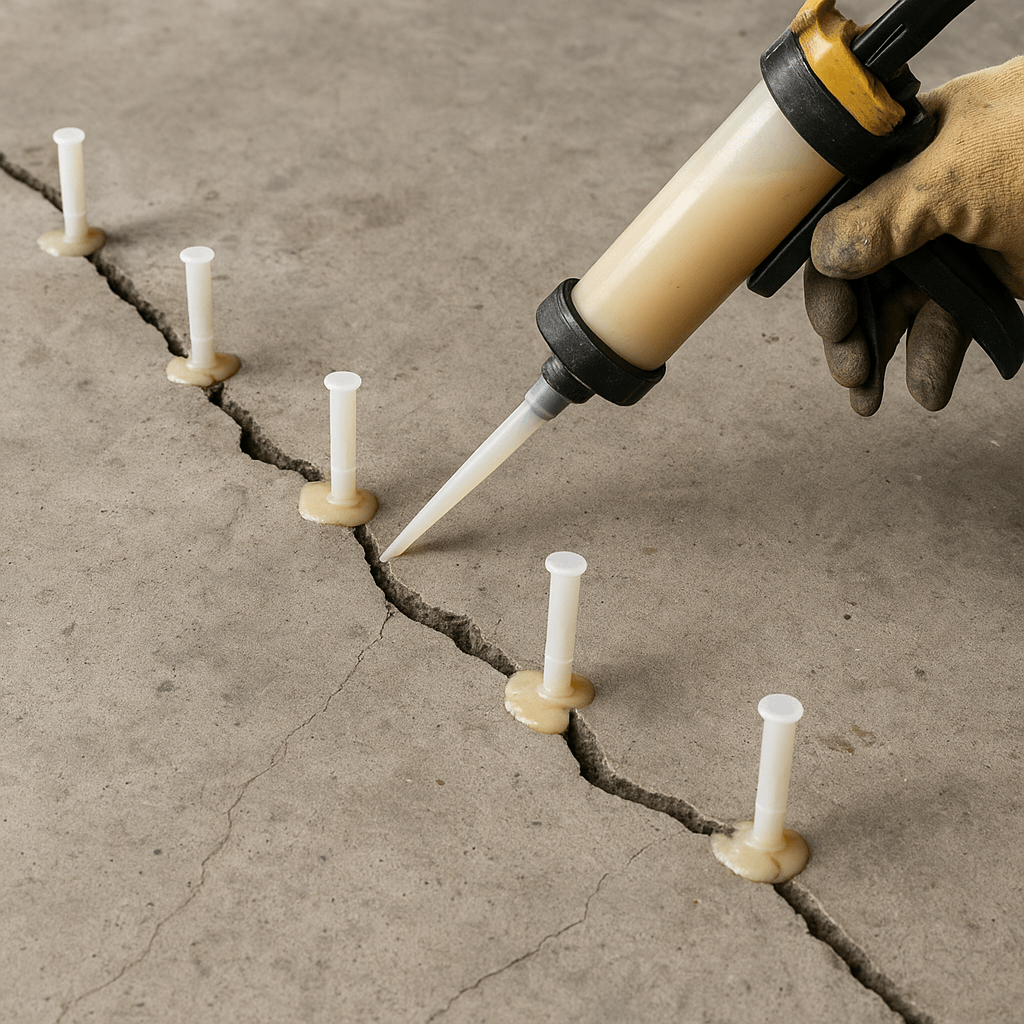Introduction
Civil engineering projects often face the challenge of cracks forming in concrete structures. These cracks can result from structural stresses, thermal variations, shrinkage, or ageing. Left untreated, they may compromise safety and durability. One proven method to repair such cracks is through the use of epoxy injection grout. In India, where infrastructure growth is rapid and climatic conditions vary, this method has gained strong relevance. Engineers rely on it to restore integrity, prevent deterioration, and enhance service life.
What is Epoxy Injection Grouting?
Epoxy injection grouting is a specialised technique used to repair cracks in concrete structures. It involves injecting resin-based material into voids and fissures under pressure. The grout bonds the fractured surfaces, reinstating structural strength and reducing permeability. Unlike surface patching, this method addresses the internal problem. By filling cracks fully, it ensures a lasting solution.
In the Indian context, where cost efficiency and reliability matter, epoxy grouting stands out. Engineers consider it an effective method because it offers high strength and long-term performance. Whether used in bridges, dams, or high-rise buildings, the method provides structural safety and resilience against environmental conditions.
Applications in Civil Engineering
Epoxy injection grout in concrete is widely applied in civil infrastructure. It restores the monolithic action of cracked sections, ensuring safety. Common applications include beams, slabs, foundations, and water-retaining structures. It is also used in industrial floors and residential homes.
In India, this method has gained attention in large projects where maintenance costs are essential. Contractors often choose epoxy grouting for bridges and flyovers which experience dynamic loads. For heritage structures, the technique is valued because it repairs without altering appearance.. Thus, epoxy grouting proves versatile across various sectors.
Types of Epoxy Injection Grout
The choice of material depends on the crack characteristics and project needs. Civil engineers typically select from two main types:
1. Low Viscosity Epoxy Injection Grout
This type is suitable for fine cracks and narrow voids. Because of its thin consistency, it penetrates deep. Engineers prefer it for hairline cracks in concrete where sealing is essential. The grout provides excellent adhesion, ensuring the crack is filled.
For structural cracks demanding greater load capacity, low viscous high strength, epoxy injection grout is implemented. It restores both tensile and compressive strength, making it ideal for critical repairs. In India’s large bridges or industrial foundations, this type is particularly critical. It helps ensure the safety and durability of heavy-duty structures.
Process of Epoxy Injection Grouting
The success of this repair method depends heavily on proper execution. Civil engineers follow a systematic process:
Surface Preparation
The surface is cleaned, and cracks are exposed. Dust, oil, or loose particles are removed for better bonding.
Sealing of Cracks
Surface cracks are sealed with an epoxy paste to prevent leakage during injection. Only entry and vent ports are left open.
Placement of Ports
Ports are positioned along the crack length. These allow grout injection at controlled pressure.
Injection Process
The epoxy injection grout is pumped in, starting from the lowest port. Engineers continue sequentially till the crack is stuffed.
Curing and Finishing
Once cured, the surface seal is removed, and finishing is completed. The structure is then inspected for quality assurance..
This step-by-step procedure ensures that the repair lasts, reducing the need for repeated maintenance.
Advantages of Epoxy Injection Grouting
- Civil engineers choose epoxy grouting because of its multiple benefits. Some key advantages include:
- Restores structural strength by bonding fractured surfaces.
- Reduces water ingress, protecting steel reinforcement from corrosion.
- Improves durability and resistance to environmental stresses.
- Provides cost-effective repair compared to reconstruction.
- Applicable to both old and new structures.
In India, those benefits align with the demand for sustainable infrastructure solutions. Repair methods that enlarge provider lifestyles without high charges are critical in a developing financial system.
Limitations to Consider
Despite its advantages, epoxy injection grout has limitations. Engineers must assess those before application. It is not suitable for cracks caused by ongoing movement or expansion. Also, moisture-filled cracks may require extra drying. The method requires skilled labour and proper equipment..
In the Indian market, the availability of trained professionals is improving, but still uneven. Thus, contractors should ensure technicians are well-trained before attempting epoxy grouting. With proper supervision, the results are reliable and long-lasting.
Quality Control and Safety
For epoxy injection grout in concrete, the quality control is critical. Engineers must check viscosity, curing time, and bond strength. Improper mixing can reduce effectiveness. Safety precautions are equally important. Workers wear protective equipment to avoid exposure to chemical components.
In India, creation sites are increasingly adopting international safety practices. However, smaller contractors need to be reminded of the importance of protective gear and environmental safety. Adopting best practices ensures successful application and safe working conditions.
Why Indian Civil Engineers Prefer This Method
India’s infrastructure demands rapid and durable solutions. Epoxy grouting is favoured because it delivers strength and economy. In areas with seismic activity, the method provides structural resilience. For water-retaining structures like tanks or canals, it ensures impermeability.
Indian engineers also value the versatility of low-viscosity epoxy injection grout for micro-cracks. Meanwhile, high strength epoxy injection grout is applied to major structural elements. Together, they cover a wide range of repair needs. This adaptability makes epoxy grouting an indispensable technique for Indian conditions.
Conclusion
Epoxy injection grouting has emerged as a reliable solution for repairing cracks in concrete structures. It is versatile, strong, and adaptable to diverse conditions. From bridges and dams to industrial plants, the method ensures long-lasting performance.
In India, the demand for durable, cost-effective repair continues to rise. Civil engineers view epoxy injection grout as an essential tool for sustainable infrastructure. By addressing cracks effectively, it extends service life and reduces overall maintenance costs.. With proper planning and execution, epoxy grouting remains a key technique for the future of civil engineering.
Constro Chem India stands as a leading epoxy injection grout supplier in India, trusted by civil engineers and contractors nationwide. With a strong focus on quality, durability, and performance, the company provides advanced solutions for repairing and strengthening concrete structures. From infrastructure projects to industrial applications, Constro Chem India delivers reliable products that ensure structural integrity, long-term protection, and customer satisfaction.

